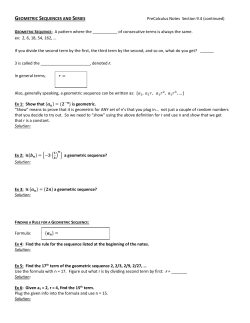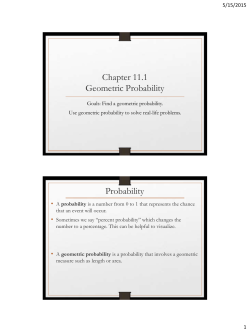
MAT 132, Calculus II SAMPLE FINAL PROBLEMS December 20, 2006
MAT 132, Calculus II
SAMPLE FINAL PROBLEMS
December 20, 2006
The exam will consist in ten problems like the ones below. Each problem will worth between
9 and 12 points.
Show all work to get full credit; a correct answer with incorrect justification will not get credit.
1. Evaluate the integrals
(a)
(b)
(c)
(d)
(e)
(f)
R
tan2 (x) sec4 (x)dx
R x2 −1
dx
x3 +x
R√
R
x ln(x)dx
x3 ln(x)dx
R
tan(10x)dx (the removed exercise
course)
R
R sin(x)
(1+x2 )
dx was beyond the limits of the
x sin2 (x) cos(x)dx
2. A function f defined on 0 ≤ x ≤ 40 has the following values
x
0
10
20
30
40
(a) (6 points) Approximate
subdivisions.
Z 40
0
f (x)
2
2.5
4.5
5
0
f (x) dx using the trapezoid rule with 2 (two) equal
(b) (6 points) Approximate the integral using Midpoint’s rule and with 2 (two) equal
subdivisions.
3. Consider the curve defined by the parametric equations x = t2 , y = t3 .
(a) Set up, but do not evaluate an integral that represents the arc length of the curve
for 10 ≤ t ≤ 20.
(b) Find the arc length of the curve when 1/3 ≤ t ≤ 1/2
dy
4. Draw the directions field of the differential equation dx
= y 2 . Use to sketch two
solutions curves, one with y(1) = 1 and the other y(0) = 0
5. Each of the diagrams below depicts the direction fields corresponding to a differential
dy
equation of the form dx
= f (x, y).
2.0
2.0
1.6
1.6
1.2
1.2
0.8
0.8
0.4
0.4
0.0
−2
−1
−0.4
0.0
1
0
2
3
4
−2
−1
−0.8
y(x)
1
2
0
1
2
−0.8
y(x)
−1.2
−1.2
−1.6
−1.6
−2.0
−2.0
2.0
2.0
1.6
1.6
1.2
1.2
0.8
0.8
0.4
0.4
0.0
0.0
−2
0
−0.4
x
x
−1
0
−0.4
x
1
2
−2
−1
−0.4
x
−0.8
y(x)
−1.2
−0.8
y(x)
−1.2
−1.6
−1.6
−2.0
−2.0
(a) Which one diagrams correspond to the function f (x, y) = x − y? (Justify your
answer.)
(b) In the diagram you found in a. sketch the solution of the initial value problem ,
dy
y(−1) = 0.
dx = f (x, y),
6. Sketch the region bounded by the given curves, and find the volume of the solid of
revolution that is formed when the region is revolved around the x-axis.
√
(a) y = x, y = 0, x = 1.
(b) y = 1 + ex , y = 0, x = 0, x = 1.
7. (a) Sketch the graph of the region determined by the curve y = cos(x), between
x = 0 and x = π2 .
(b) Compute the area of this region.
(c) Compute the volume of the solid obtained by revolving this region about the
x-axis.
(d)
8. Suppose that y(x) satisfies the differential equation y 0 =
y2
x
(a) Give a general solution.
(b) If y(x) is a solution and y(1) = 0, find y(x).
9. Consider the differential equation
dy
dx
= y − x2
(a) Determine which one of the following functions is a solution, explaining your
reasoning (C is a constant).
i. y(x) = cos(Cx)
ii. y(x) = 2 + 2x + Cx2 + ex
iii. y(x) = 2 + 2x + x2 + Cex
(b) Solve the initial value problem
dy
dx
10. Let {an }n≤1 be a sequence with an =
= y − x2 , y(0) = 3.
cos(n)
2n .
(a) List the first, third and tenth term of the sequence.
(b) Determine whether the sequence if convergent and if so, find the limit.
(c) Determine wether the series
P∞
n=1 an
is convergent.
11. Write the infinite repeating decimal 0.55555... as a geometric series. Use the formula
for the sum of a geometric series to express this as a fraction (ratio of two whole
numbers).
12. Write the infinite repeating decimal 0.17171717... as a geometric series. Use the formula for the sum of a geometric series to express this as a fraction (ratio of two whole
numbers).
13. Determine if the following series converge or diverge. Justify.
(a)
∞
X
1 + n2 2−n
(b)
n2
n=1
14. Let f (x) =
∞
X
2n + 1
n=1
n3 + n
(c)
∞
X
cos n
n=1
(d)
n2
∞
X
2n
n=1
n!
1
1−x .
(a) Write down a power series which equals f (x) for all |x − 3| < 1.
(b) Write down a power series which equals (x − 3)f 0 (x) for all |x − 3| < 1.
15. (a) Write f (x) =
1
2+x2
as a geometric series.
(b) Use the power series representation of f to find calculate the twentieth derivative
of f at x = 0.
16. Find exactly for which values of x each of the following power series converges.
(a)
∞
X
n
e
n=1
(x − 3)n
n
17. Find the exact value of
(b)
∞
X
ln n
xn
ln(n
+
1)
n=1
(c)
∞
X
3n
n3
n=1
xn
∞
X
2n
n=0
n!
18. Evaluate the indefinite integral
R sin(x)
x
as an infinite series
19. (a) Find all the real functions y(x) which satisfy the equation y 00 + y 0 + 2y = 0.
(b) Find all the real solutions passing though the point (0,1). How many of these
can you find?
(c) Find all the real solutions whose derivative passes through the point (0,-1).
(d)
© Copyright 2025





















